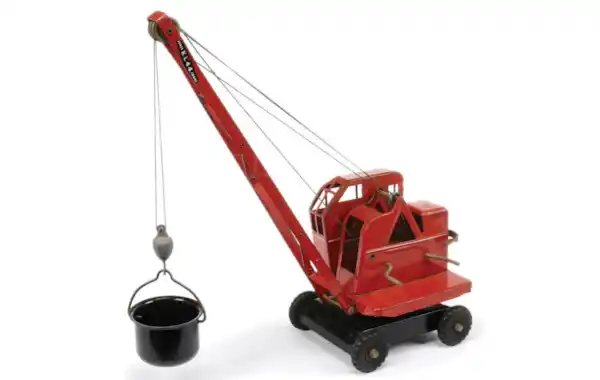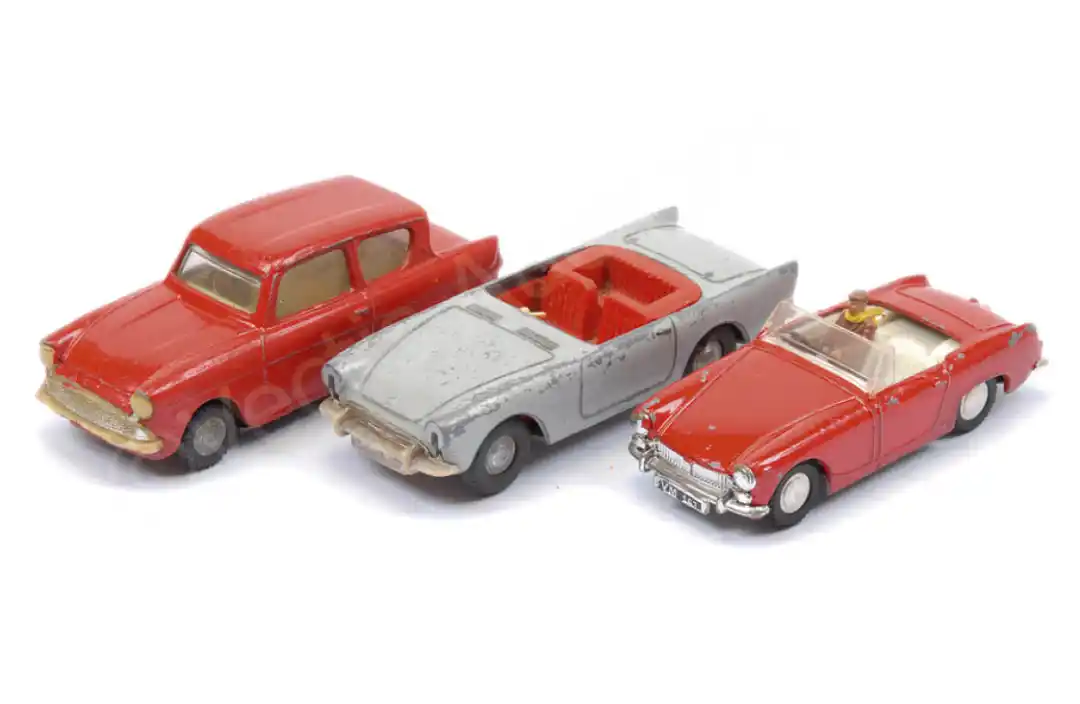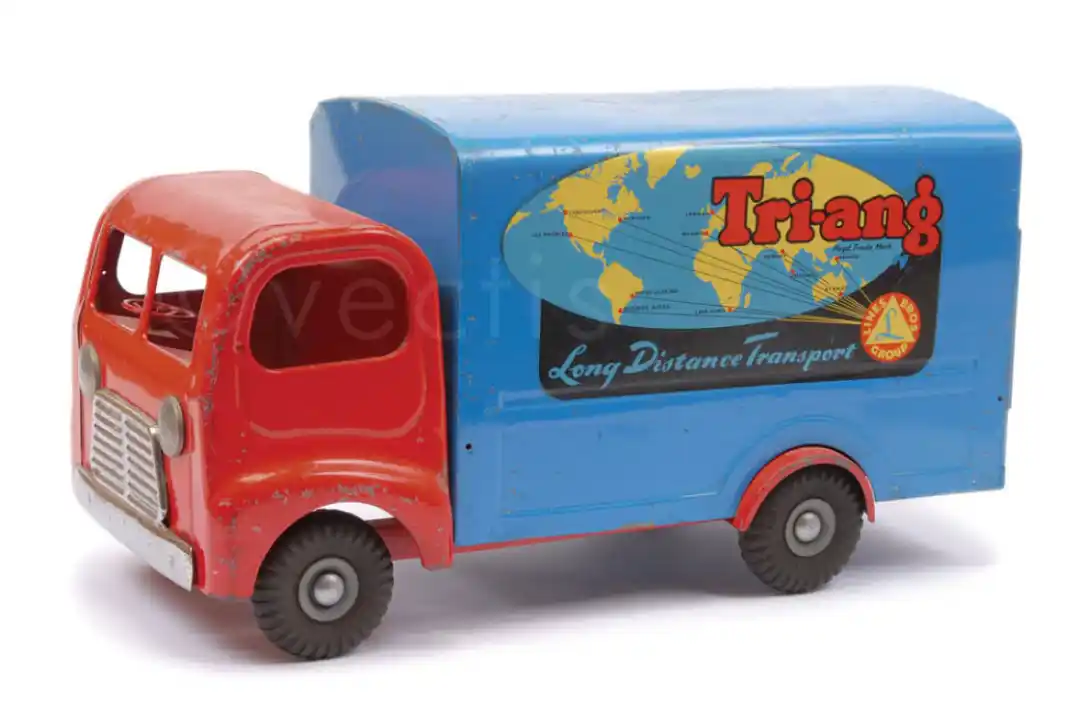04 February 2019
|
Examining the history of some of Britain’s great toy makers - Tri-ang
Tri-ang Toys: Best of British
Think of Tri-ang toys and more often than not the mind instantly conjures up images of those chunky robust pressed steel vehicles that many of us gave so much hammer as kids. They seemed almost indestructible and many would bear the full weight of a child without any problem. Indeed some were actually designed for riding on. I remember having a red truck with a big bonnet and chunky rubber tyres that we use as a makeshift skateboard when the tipper back broke away from the chassis. I also remember my friend owning a crane that gave us hours of fun in the sandpit our tiny fingers vigorously winding the handles on the side to raise the grab line bucket and tip sand into a waiting tipper truck.
The history of Tri-ang Toys can be traced back to around 1850 when the Lines family set up a toy making business at Bagnidge Wells, an early spa village located north of London. At this time the mainstay of the business was wooden toys including wooden horses. Not all of these horses were for children, however. In those distant days the bespoke saddlers of London required life size horses on which to display their saddlery goods so there was a good trade for the Lines family in making these huge display pieces.
Toys, however became the firm’s mainstay and in 1876, needing more space, brothers George and Joseph Lines established a new factory in a former steam works at 457 Caledonian Road, close to where St Pancras Station now stands. This factory began making all manner of playthings for the children of the wealthy London upper and middle classes. These included rocking horses, velocipede horses, toy horse and cart combinations with iron wheels, dolls houses, toy forts, horses for fairs and steam circuses, garden swings and even wheelbarrows. The factory thrived and soon over one hundred craftsmen were employed in the business. Desperately in need of even more space the G&J Lines factory was substantially expanded absorbing the former North Road Cattle Market and a factory previously used by an Italian ice cream vendor. A little later Lines also purchased the old depot and stable yard of the London General Omnibus Co.
Expansion continued at a pace and over in Hackney the business of one of London’s oldest toymakers, Allen & Co, was absorbed into the Lines fold. This was the first of many such takeovers made by Lines bros throughout its history.
In 1887, the year of Queen Victoria’s Jubilee, G&J Lines developed a new toy horse which became known as the ‘Jubilee Hobby Horse’ and these were supplied to London’s leading toy retailer Gamages along with other Lines rocking horses and push along toys.
In 1910 G&J Lines adopted a thistle as its Trade Mark and three years later the company left Caledonian Road to develop a new factory on a four and a half acre site in Down Lane, Tottenham which was designed to incorporate its own railway track greatly enhancing distribution of goods through the ever expanding rail network.
In 1919 Joseph Lines three sons William, Arthur and Walter returned to the company after serving in the Armed Forces during the Great War. The brothers were eager to establish their own company and quickly set up Lines Brothers Limited taking over premises on Ormside Street off London’s Old Kent Road. With Walter Lines largely in charge of design they soon forged links with overseas customers and also supplied London’s famous department store Harrods with toys. The brothers were so successful that in 1924 a move was made to a much larger new factory at Merton in South London.
It was at this time that Lines Brothers Ltd adopted its world famous Tri-ang Trade Mark. The red triangle design reflects three equal lines representing the three Lines brothers. There were, however three other directors at the helm of the company: G.M. Campbell, R.C. Munro and R. Freeman. The latter two men both came from an engineering background so it was no surprise that Lines Brothers early Tri-ang offerings were very sturdy well-built toys constructed with a combination of wood and metal with plenty of play value.
The late 1920s saw the release of a delightful series of Tri-ang road vehicles known as the Dolls Motor Vans. These had wooden wheels and tinplate radiators. The next series included some splendid touring cars, a smart Charabanc and a motor taxi.
It was back to wooden construction for a small range of vans with Bull Nose radiators and many of these vehicles carried advertising for national newspapers and Carter Paterson parcel deliveries.
A tipping wagon and an impressive box van were produced in the ‘Titan’ series in the late 1920s boasting new innovations such as ‘real steering’ and smart rubber tyres. One of the most impressive toys of this period was a super red fire engine with a metal bell and removable ladder. This toy was still part wood and part metal in construction.
All of the above mentioned early Tri-ang motor vehicles are now sought after collectors’ items and finding them in above average condition is difficult.
All-steel Tri-ang lorries were first made in 1930 finished in stove enamelled paint and steel wheels with rubber tyres. The six different trucks in this range were a van, petrol tanker, breakdown wagon, timber lorry, milk lorry and a Carter Paterson box van. Before long these pressed steel trucks (many of which were based on a Bedford lookalike vehicle) began rolling off the production line in their thousands and the Merton factory workforce doubled to around 1,000 by the early years of the 1930s.
In 1931 Line Brothers Ltd bought Hamleys, London’s famous toy retailer who were financially overstretched following the building of its fine new department store.
Lines Bros went public in 1933 with the issue of 200,000 shares and the business developed greatly throughout the 1930s.
Tri-ang pressed steel lorries were made until the outbreak of World War II during which the whole Merton factory was requisitioned by the Ministry of Defence and turned over to making machine guns, shell cases and magazines for Spitfire and Hurricane fighter planes. It was Lines Brothers engineers who were largely credited with the development of the Sten Gun at the Merton factory during the war.
When toy production resumed after the war the pressed steel Tri-ang range re-emerged and by the 1950s the old bonneted cabs were replaced with new more modern looking forward control units. The 1950s became the heyday of pressed steel toy production with all manner of different cranes, trucks, pedal cars and tractors rolling off the production line. To list them all here would be an impossible task. Needless to say Tri-ang toy collectors have plenty of examples to search for and some of the rarer examples now change hands for considerable sums of money.
Lines Bros opened two new factories after the war in Merthyr Tydfil, Wales and in Belfast, Northern Ireland… the latter being used mainly for soft toy production. By the mid 1960s Tri-ang owned over forty different business organisations, many of which (including Meccano and Hornby) had been taken over as part of the expansion of its worldwide operation.
Despite being Britain’s largest toy manufacturer, Tri-ang began to run into problems in 1971 following a sudden drop in demand for its products in the UK. A deep recession had set in to British industry and, like so many other great names of the British toy industry, Lines Bros and Tri-ang and its many other famous subsidiary companies eventually succumbed to the liquidators.
Collecting Tri-ang pressed steel and tinplate toy vehicles can be great fun but you do need plenty of space when it comes to putting them on display!













-Osprey-Ocean-Cabin-Racing-Yacht-79534.jpg?&mode=crop&format=webp&webp.quality=40&scale=both)
